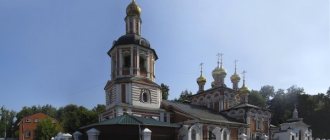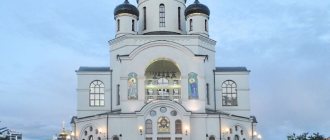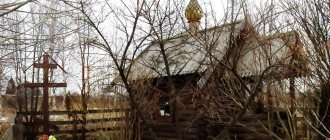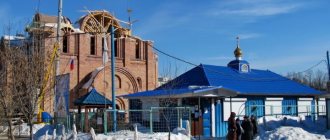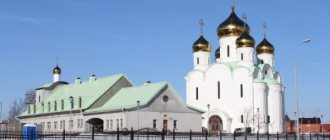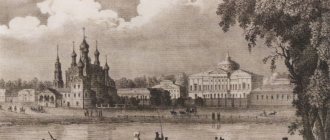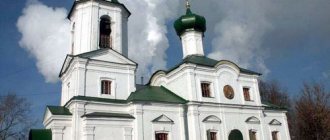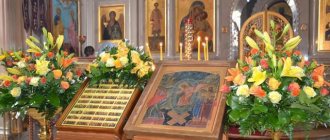One of the oldest Moscow churches dedicated to the Mother of God is the Church of the Assumption of the Virgin Mary in Veshnyaki. Veshnyakovo is a place known since the 16th century; these places are associated with the name of the famous Russian statesman - Fyodor Ivanovich Sheremetyev, who founded the Assumption Church here in 1644.
Church of the Assumption of the Blessed Virgin Mary in Veshnyaki, Moscow
Who is it named after, the significance of the temple today
The Church of the Assumption of the Blessed Virgin Mary in Veshnyaki is known by the name of the altar of its lower, main church. It was consecrated in honor of the feast of the Assumption, revered in Rus', which was especially loved by the peasants.
Back in 1644, the Church of the Assumption of the Blessed Virgin Mary was founded in Veshnyaki. For centuries, he delighted parishioners with divine services, sacraments and rituals. It continues to function today.
The holiday itself refers to the number of the twelve and the event of the Dormition of the Mother of God, which was accompanied by various miracles: all the apostles who were preaching throughout the world at that time were gathered for it by divine providence, and many people received healing from the tomb of the Mother of God.
The second important throne of the temple is called the Resurrection of the Word, although it was originally the throne of the Resurrection of Christ. This error or deliberate substitution was discovered in Soviet documents for the closure of the temple, but its source was never found.
Today the temple is not only an important place for believers, but also an architectural monument and an object of cultural heritage of the city. Its unusual reason for construction, the complex fate and amazing preservation of old icons and Russian architecture helps to feel one’s own involvement in the history of the city, both on the part of the worldly authorities and on the part of the Russian Orthodox Church.
Rebuilding the temple
Subsequently, the church was rebuilt many times by the Cherkasy and Odoevskys. They were the heirs of the Sheremetevs.
In the period from 1732 to 1734, Prince Alexey Mikhailovich of Cherkassy began to fundamentally rebuild the church. He wanted the temple to be designed in the European Baroque style that was current at that time. The bell tower was redone beyond recognition, but the work stopped there. The year 1743 was marked by the fact that Veshnyakovo again returned to the possession of the Sheremetev boyars.
Architect, exterior decoration, architectural ensemble
The exact name of the architect has not been preserved, but it is believed that he was one of the Moscow masters of that time, who could be engaged in the construction of similar temples on the territory of Moscow and nearby cities and villages. Initially, the temple was a building on a high ground floor, which was called a basement and was very common in temples of that time.
The structure was surrounded on three sides by an open gallery. On the ground floor there was a “winter” unheated temple. After the construction was completed and services had already taken place, additional symmetrical chapels were added to the temple. Both the lower and upper temples are now functioning. In addition to the temple building, there was a priest’s house and a garden.
Also on the territory of the temple there is a small open chapel where anyone can light a candle and pray, a canteen and a Sunday school building.
Externally the temple is decorated with facing bricks. The domes, originally monochromatic, are painted blue with the placement of stars - the symbol and color of the Virgin Mary. The side chapels are below the main building of the temple.
The outside walls are decorated with various architectural elements: semi-arches protruding upward, icons on the outside, decorations above the windows and semi-columns. The gate outside the temple premises is made in the same style.
The Church of the Assumption in Veshnyaki is covered with cracks. Residents appeal to the Patriarch for help
The northeastern chord may cause the destruction of the Church of the Assumption in Veshnyaki. Desperate to find justice in the fight against officials and developers of Kuskovo Park, Muscovites went all the way to the President himself.
But - in vain. Part of the forest was cut down, despite the signatures of 145 thousand people in defense of the park. Now activists are fighting for the safety of the Church of the Assumption of the Mother of God in Veshnyaki. The temple is covered in cracks, according to activists of the VOOPiK movement. They asked the Patriarch of All Rus' Kirill to help protect the ancient temple. The activists' text can be found below.
Also, I present in full the report of VOOPiK on the reasons for the appearance of cracks in the beacons on the walls of the 16th century Church of the Assumption in Veshnyaki. YOUR HOLINESS, GRACEFUL ARCHIPASTER AND FATHER! The building of the 370-year-old Church of the Assumption of the Blessed Virgin Mary in Veshnyaki - a cultural heritage site of federal significance - was damaged during the construction of the North - Eastern chord.
As a result of the excavation of the heating main pit near the Temple fence, soil movement occurred, and at the buttress of the southern wall of the Temple closest to the pit, subsidence of the southern and eastern walls occurred relative to it. 1. This shows the progressive opening of cracks in the southern and eastern walls of the Temple at the corner of their junction, overlooking the construction chord and the foundation pit.
note
We published a photo of the crack a year ago, warning about the inadmissibility of construction near the Temple. After excavating the pit, its opening width increased from hairline to coarse (1-2 mm) with a depth of up to 600 mm. See below for location of cracks.
photo 1 1
BUT OUR WARNING WAS WASHED AWAY, AND NOW IT CAME OUT - THE TEMPLE IS SETTING, THE SOIL FOUNDATION IS LEAVING FROM UNDER IT, AS A CONSEQUENCE OF THE EXCAVATION OF THE PITCH FOR THE HEATING ROUTE, which caused movement of the soil from the Temple to the pit.
Photo of the location of the pit relative to the Temple, taken by a drone, see photo 2 below. On the right side of the picture you can see the territory of the Temple and the route of the pit, running close to the fence of the territory and partially along the territory itself, located behind the fence at the corner of the fence turn to
entrance to the Temple. On the left side of the photo you can see the tracks of the Ryazan Moscow Railway and the Veshnyaki platform, onto which the cracked wall of the Temple overlooks. Between them, a six-lane highway is being prepared, with a traffic flow of 10,000 cars per hour. It is impossible to find a more unacceptable place for a chord.
We measured the opening (width) and depth of the crack by inserting wire probes with a diameter of 1 mm into the crack at different places along its length. According to the classification, a crack of 1 mm is classified as large. The length of the crack is 1830 mm.
The crack is through, it runs through the entire angle formed by the junction of the southern and eastern walls of the southern aisle of the Temple, starting on the eastern wall (not reaching the apse) and ending with an exit to the southern wall.
In fact, this southeastern corner was torn away from the eastern and southern walls that formed it. It came off together with the buttress, which reinforces this corner, due to the fact that the walls are sagging relative to this corner and the buttress. If the subsidence of the walls does not stop, the Temple will collapse. For photos of cracks at this corner, see pages 3 and 4.
This relatively dry autumn, and even more so the winter, will help slow down and stop the subsidence, but in the spring the process will resume. We remind you that the soils of Veshnyaki are unstable, water-saturated, and belong to the category of flooded and flooded (see “Conclusion ..." State Economic Examination page 10 by order 302-08-00 2014).
In the spring, because of this, gaps often form in the soil between the Temple and the railway due to vibrations from passing trains.
The measurements of the crack were taken not on the surface of the wall, but to what depth and in what direction a probe with a diameter of 1 mm penetrates into the crack. The measurement results are depressing. A crack 1 mm wide (opening) has a depth of more than half a meter. In this case, cracks penetrate the corner of the southern and eastern walls of the Temple in directions relative to the surface of both of these walls of the order of 30-45-60 degrees. The measurement results are shown in photos 3, 4 below. They show specific locations for measuring the width (opening) and depth of cracks. At each measurement point there is an inscription about the diameter of the probe and the depth to which the probe easily entered the crack. The numbers and coordinates of the measurement sites are given. Dimensions are given in millimeters.
Wall cracks are classified by dividing them into groups according to the opening size: large - more than 1 mm, small - up to 0.3 mm, hairline - up to 0.1 mm, developed - up to 0.5 mm. Before the excavation of the pit, when we published a photo of the crack in November 2021, it was hairline - no probe went into it.
Important
Now a probe with a diameter of 1 mm and a length of 600 mm completely fits into the crack from the south wall (see point 3 in photo 4). Naturally, the crack does not end there - it bends or narrows so that a probe with a diameter of 1 mm does not pass freely any further.
There are also millimeter-wide cracks on the eastern wall, as well as a 2-millimeter crack with a depth of 280 mm (point 1 in photo 3).
In total, two cracks of 600 and 280 mm on both sides with a total depth of 880 mm completely cut off a 1040 mm wide buttress with adjacent parts of the walls from the Temple building. 2 The dimensions of the depth and direction of the cracks show that the wall and foundation of the Temple are settling down relative to the lighter buttress, which therefore remains on the surface of the earth. In photo 5 (p.
5) shows what a crack looks like in full size. To do this, a ruler was placed on a crack on the day surface of the Temple wall. The scale of the photo is 1:1 to the texture, that is, those who wish can attach their own ruler to this photo, make sure that its divisions coincide with the ruler in the photo and measure the width of the crack with their ruler.
This will correspond to the measurement of the thickness (opening) of the crack carried out in situ on the Temple
Source: https://anna-nik0laeva.livejournal.com/649274.html
History of construction
The history of temple construction is connected with the location of an ancient estate here, associated with the boyar family of the Sheremetevs. They owned the Veshnyakovo estate and they, and specifically F.I. Sheremetev, founded the Assumption Church in 1644.
He was a well-known political figure of his time, and, thanks to his works, the Treaty of Polyanovsky was concluded, which ended the Russian-Polish war in 1634 and removed the Polish threat. Then he decided to step away from government affairs and build a church, in accordance with the vow he had once given. Soon after the completion of construction, Sheremetev resigned and became a monk.
Construction was completed by 1647, but in 1655 it was decided to enlarge the temple and add additional chapels to it. They turned to Moscow Patriarch Nikon for his blessing for completion. He expressed his agreement and added a note about domes, prohibiting them from making them pointed in the future.
At that time, hipped temples were popular, in which instead of onion domes there were pyramidal and high ones. The main dome of the church was already made as a tent dome and was not altered. Nikon was an opponent of such toppings for churches and in every possible way insisted on a new type of churches with one or more obligatory round domes.
The bell tower was added in 1695
Later, around 1695, a bell tower was added to the temple, and in 1734 the hipped dome was completed. The Church of the Assumption of the Blessed Virgin Mary in Veshnyaki has experienced many reconstructions, restorations and changes in external and internal appearance. It is impossible to say for sure whether this was due to poor quality construction or to the wishes of those who owned the land, but the temple was repainted several times.
During the reconstruction of the walls, layers of previous paintings were discovered, of which there were more than 12. At different times, the temple was painted in different colors, based on the side chapels: yellow and emerald hierarchical shades, burgundy and red – martyr shades. During Soviet times, the temple was seriously damaged: already on May 22, 1922, the removal of various jewelry and antiquities began from the temple.
The following were taken out and disappeared without a trace:
- gold and silver jewelry;
- vestments on icons;
- old Gospel;
- altar and altar cross;
- tabernacle;
- candlesticks;
- sacred vessels and communion cups;
- many vestments;
- handmade shrouds;
- fabrics.
Despite this, the church continued to function, services were held here, and the community gathered until 1940, when the church was closed and refurbished.
During the war, the building was used as a military warehouse, and the side aisles were used as repair shops, after which there was a canteen and a stable.
In 1947, the temple was transferred back and services continued here again. Although many valuables were confiscated, some were preserved in the homes of parishioners and hidden in the bell tower. In particular, ancient icons were saved in this way, although storage in a damp place and due to temperature changes damaged both the boards and the paint. Later the icons were restored.
Video - history of the temple and some general information:
After the church building was returned to the parish, large-scale renovation work was carried out here. The temple was restored to its original appearance, and the heating was also turned on. Now the upper church was also suitable for winter services. In 1951, the work was completely completed, the bell tower was the last to be repaired and the spire was restored.
History of appearance
The church in Veshnyakovo was built by boyar Fyodor Ivanovich Sheremetev in 1646 with the blessing of Patriarch Joseph. The church was built directly from stone and was named the Temple of the Assumption of the Blessed Virgin Mary. In its four-hundred-year history, it was closed only once.
Fyodor Ivanovich himself, a commander and statesman under Tsar Mikhail Fedorovich, soon took monastic vows at the Kirillo-Belozersky Monastery with the name Theodosius and in 1650 he peacefully passed on to the Lord.
Sheremetev's heirs invariably took care of the splendor and decoration of the church. It was rebuilt several times, the color of the building changed many times. It was originally burgundy, then emerald, yellow and white today. The last major reconstruction was carried out at the end of the 19th century under the rector, Archpriest Konstantin Zverev, who served in this place for many years. Here he met Tsar Alexander III with his heir, the future Tsar-Passion-Bearer Nicholas II.
The walls of the sanctuary have seen many kings. Tsar Alexei Mikhailovich and Empress Catherine the Second visited here. The last from the reigning house to visit the temple in Veshnyaki were Grand Duke Sergei Alexandrovich and his wife Grand Duchess Elizaveta Feodorovna.
Hieromartyrs Sergei Tsvetkov, Ivan Yanushev, Ivan Plekhanov, the former cook of His Holiness Tikhon, served here.
It is possible that you will be interested in an article about the Church of the Nativity of the Blessed Virgin Mary in Krylatskoye.
Interior decoration
Despite various reconstructions, the temple managed to preserve enough ancient icons, an iconostasis and an almost untouched interior appearance. Now in the lower church there is an ancient iconostasis of unknown masters. There are icons on the iconostasis: many of them are very dark from time to time and will gradually be reconstructed.
The main work on the interior decoration took place in the 1950s, then the missing parts of the iconostasis were added, and icons were inserted that matched the style of the surviving ones. The floor of the temple was newly decorated and finished; instead of planks, a special mosaic floor was laid in the ornamental style of the 17th century.
A. T. Silin, a famous Moscow artist, worked on the central altar. Through his efforts, icons were painted for the iconostasis of the side chapels, as well as icons for the central iconostasis and paintings inside the altar. In 2003, the temple was repaired and re-painted.
Now the interior walls are completely decorated with paintings of biblical scenes, stories of the New Testament, and icons of local saints are placed here. The temple is richly decorated with plant ornaments. In 2014, a precious robe and crown were made for the Iveron Icon.
Shrines, relics, icons of the temple
The Church of the Assumption of the Blessed Virgin Mary in Veshnyaki is directly related to the lives of four holy martyrs, who were glorified among the Council of New Martyrs and Confessors of Russia. In the temple there is a list of icons with particles of relics.
The icon depicts four holy martyrs, next to them is the church in Veshnyaki:
- Hieromartyr Peter , Archbishop of Voronezh, as a child helped his father during services in this very church. In 2009, after the transfer of the relics to Solovki, at the request of the Rostov Metropolitan, a particle of his relics was transferred to the Church of the Assumption for permanent residence here.
- Hieromartyr Sergius (Tsvetkov) served in the church in Veshnyaki as a deacon and priest since 1892.
- Hieromartyr Priest John (Plekhanov) was ordained to the priesthood in this church in 1925.
- Hieromartyr Archpriest John (Yanushev) was appointed here by decree of the metropolitan in 1935. The Day of Remembrance of the New Martyr is revered on a par with patronal feast days.
The temple contains many ancient icons, which were miraculously preserved. Some of them could not be restored. The iconostasis in the lower church, icon cases and iconography from the century before last have also been completely preserved. The upper church houses images of the Vladimir Icon and the Savior, painted by Tikhon Filatyev, the royal icon master, in the 17th century.
Confiscation of church valuables, closure of the temple
In 1922, the church suffered a sad fate. Temple valuables were confiscated (in other words, a robbery was carried out, covered with beautiful slogans), but it was not closed immediately - only eighteen years later.
Believers from the nearby villages of Nizovki and Vykhino secretly took some objects home, including the Royal Doors that blocked the altar.
Clergy and mentors
Today, the temple has a full-fledged priestly staff. The rector is Hieromonk Afanasy (Ivanov), a candidate of theology, graduated from the Perervinsky Theological Seminary and graduate school at the Moscow Theological Academy. In 2012 he was tonsured a monk.
Deacon Dimitry Kelmanov is transferred to the priesthood
The concelebrating priest is Archpriest Vasily (Klochkov), graduated from the Moscow Theological Seminary, a priest since 1996. The priestly staff also includes Priests Dimitry (Serikov), Alexander (Podpalov), Dmitry (Kelmanov).
Priests Demetrius and Alexander were repeatedly awarded church awards, such as a double orarion, a nabedrennik and a kamilavka.
Since 1991, Protodeacon Alexander (Kargin), winner of the Medal of St. Sergius of Radonezh, 1st degree, and the Order of the Holy Blessed Prince Daniel of Moscow, 3rd degree, has served at the church for church services.
Social work, everyday life
The Church of the Assumption of the Blessed Virgin Mary in Veshnyaki is active on social networks. In addition to the official website, there are several other pages where current news, photo reports and schedules are posted. In addition to Sunday school, there is also a youth association, which includes both Sunday school graduates and all interested young people.
Wedding
The association was created in 2010 and since then has become an integral part of the parish. Orthodox youth of the Church of the Assumption of the Blessed Virgin Mary take an active part in various events in Veshnyaki, participate in sports competitions, and engage in volunteer work. The youth association also takes part in the events of the Synodal Department for Youth Affairs.
For students and adult parishioners, there are pilgrimage trips to neighboring cities, visits to monasteries and shrines in other churches, and the opportunity for obedience and labor.
History of construction
The Mother of God has always been especially revered in both Orthodox Christianity and Catholic Christianity. For a woman she is the first intercessor, for a mother she is an assistant. She, the Blessed Virgin, is offered prayers by those who desperately need help and peace of mind. This is probably why there are so many churches dedicated to the Mother of God in Russia.
It is known that Fyodor Ivanovich Sheremetyev, having a high position in the government, made a vow in the middle of the 17th century, according to which the Church of the Assumption of the Blessed Virgin Mary was built. With the start of construction, Sheremetyev refused his honorary position and soon took monastic vows and a new name - Theodosius.
From that time until the end of his days, his main task was to take care of the temple. By the beginning of 1734, the construction of the temple was completed, and for a long time the temple did not need restoration.
However, during the Soviet period, like most churches, the temple was looted by the Bolsheviks. And, despite the fact that services were held in the church until the last day, in 1940, on the eve of the Great Patriotic War, the church building, by decision of the authorities, was transferred to workshops and military warehouses. Only 2 years after the victory of our troops in the war, in 1947, services were resumed in the Assumption Church.
Moreover, thanks to local residents, during the difficult years for the church, the main relics of the cathedral were saved - 3 ancient icons.
Sunday School
On the territory of the temple there is a Sunday school for children of all ages. Depending on age, students are divided into classes where they study their subjects. For elementary school students, these are lessons in the law of God, church reading, and prayer lessons. Children go through the most important biblical events, studying them through play and performing various creative works, drawings and crafts.
Christmas in Sunday School
For children of the middle and older groups there are lessons in biblical history, Church Slavonic language, and singing lessons. Sunday school students regularly stage various performances on church holidays, and children have tea parties and socializing with friends.
Patronal holidays
The temple contains the main lower altar in honor of the Feast of the Assumption (celebrated on August 28), the altar of the upper church and several altars in the side chapels. The chapel of the lower church was consecrated in honor of St. Sergius of Radonezh (memory day October 8, July 18 the day of the discovery of relics), the greatest founder of monasteries, the founder of eldership in Rus' and the greatest ascetic of the Russian land.
Palm Sunday
The main altar in the upper church is consecrated in honor of the Resurrection of the Word: a holiday in honor of the consecration of the Church of the Holy Sepulcher in Jerusalem at the site of the burial and resurrection of Jesus Christ, its celebration is celebrated on September 26. The southern aisle was consecrated in honor of the revered Nicholas the Wonderworker (December 19 and May 22).
The northern aisle was consecrated in honor of the biblical prophet Elijah (August 2). An additional “side chapel” was consecrated in honor of the martyr Tatiana of Rome, her memory is celebrated on January 25.
Temple during the Soviet years
On September 13, 1940, by decision of the executive committee of the Moscow Regional Council, the temple was closed and was not used in any way before the war. As the Germans approached Moscow, workshops for repairing tank engines, then a military warehouse, and a canteen were located here.
It is known that during the war, when the church was closed and the iconostasis was dismantled, local residents of the nearby villages of Vykhino and Vyazovka took what they could carry away - the most revered icons. They were kept in their homes until the temple was returned to the believers.
Despite the efforts of parishioners to save as many relics as possible, many icons of the ancient church had to be stored in the bell tower, where they died from temperature and humidity changes.
The Veshnyakovskaya Church was returned to believers in 1947, and on January 25, the day of remembrance of the martyr Tatiana, the first liturgy was served here
Service schedule, operating hours
The Church of the Assumption of the Blessed Virgin Mary in Veshnyaki is open daily from 7:00 to 21:00.
| Monday, Tuesday, Thursday |
|
| Wednesday Friday |
|
| Saturday |
|
| Sunday |
|
Relics and architecture
Today it is a majestic building. The central quadrangle is built on the vaulted basement. There are two aisles and a three-tiered bell tower topped with a spire.
After the war, a team of artists led by Korin worked on the restoration of the icons. The images are painted in the Old Russian style, with partial gilding.
To the left and right of the royal gates are icons of the famous royal isographer Tikhon Filatyev. This is the famous “Savior Pantocrator” and the icon of Our Lady of Vladimir.
The frescoes of the upper temple were painted in the 19th century and have survived to this day.
In the lower Assumption Church there is a famous image of the Savior Not Made by Hands. The most candles always burn near this icon. There is evidence of miraculous healing after prayer in front of this face.
The most revered icons of the church:
Thomas' Assurance; Tikhvin Mother of God; Recovery of the Dead; Iveron Icon of the Mother of God; Carrying the Cross.
The central altar is dedicated to the Dormition of the Blessed Virgin Mary, one of the largest church holidays in Rus'. In the lower church there is an ark with particles of the relics of the holy saints of God.
To the right of the temple icon of the Dormition of the Virgin Mary is the image of the New Martyrs and Confessors of Russia, whose life path is connected with this place. The icon depicts the Church of the Dormition of the Blessed Virgin Mary itself, and next to it stand the same holy martyrs who once served here and now have the grace to pray for people before the Throne of God.
Information for pilgrims
The temple is open to visitors every day. You can order additional services, such as prayer services or memorial services. In the temple you cannot take photographs with flash or sound, and you cannot take photographs during services. To obtain permission, you must seek a blessing from a priest and do this in advance.
In the church shop you can order a service or buy an icon
Many temple icons are ancient, so excess light is undesirable for paint. You cannot approach icons with painted lips, and to visit the temple it is best to do without makeup.
One thought on “Church of the Assumption of the Blessed Virgin Mary in Veshnyaki”
- Love
February 7, 2019Reply Dear Sirs! With all my heart I wish you to prosper luxuriously with Saint Tryphon! Tryphon in the lane from Greek - luxurious. A huge request to hold a prayer service for the repose of Fyodor Praskovya Spiridon Savely Innocent Anatoly Olga Maria Mikhail Anna Alexander Euphrosyne Varvara Matryona. And also for the health of the babies Philip Oscar and their parents Yulia Alexey Denis. Sergei Lyubov. And they will light candles for your prosperity. We thank you for everything.
Where is it located, what is in the surrounding area, how to get there
Temple address: st. Yunosti, 17 building 4, Moscow. The nearest metro stations are “Vykhino” and “Ryazansky Prospect”, then you can get to the temple by buses No. 127 and No. 620, or No. 133 and No. 208. You can also walk, from the Vykhino station the journey will take approximately 15 minutes, from Ryazansky Prospekt approximately 40-45 minutes. The walk from Kuzminki station will take about an hour.
Not far from the temple you can see the Kuskovo estate, the Sheremetyev estate. Now this architectural ensemble is open as an exhibition of architecture and park, where you can see collections of porcelain and glass. The estate became the backdrop for the filming of various historical films. You can get there on foot towards the park, the journey will take about 30 minutes.
The Church of the Assumption of the Blessed Virgin Mary is now a decoration of Veshnyaki. This is an ancient building that allows you to touch history in the most literal sense of the word, to see relics and icons that have been preserved through the years thanks to human indifference.
Author: Katya Volkova
Design: Nadezhda Saltsova
Schedule of services
For everyone, the Cathedral of the Presentation of the Blessed Virgin Mary is open from 8.00 to 19.00, parking on the territory closes later - at 20.00. On weekdays, Christians come to the morning liturgy at 8.00, on weekends an evening service is added at 17.00.
You can go to confession every day during church services. On Christian holidays, service hours are specified in the schedule.
Contact details
Address of the Cathedral of the Entry into the Temple of the Mother of God: st. Ketcherskaya, 2a. You can check the schedule of holiday services by calling the number.
It's a 15-minute walk from the station. metro station "Novogireevo". You can also get there by bus No. 21, stop. "Petrovsky Market - Novogireevo Platform." Those who travel by train in the Gorky direction need to get off at the Novogireevo Platform station.

